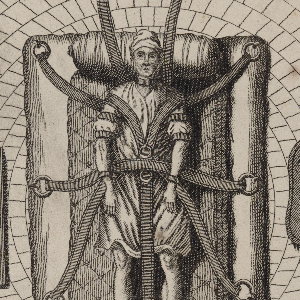Early Modern (1450 CE - 1800 CE)

Removal of the Parlements
The French Revolutionary engraving's depiction of the physical eviction of the black–robed magistrates in front of a female audience has a somewhat ambiguous message.

Damiens Being Broken on the Wheel
This straightforward representation of Damiens gives no hint of sympathy for a would–be pre-revolutionary royal assassin.
The Coronation of Louis XVI from the Gazette of France (1775)
These two articles from the official newspaper of the day describe the coronation of Louis XVI at Reims, the city to which French kings had traveled to be anointed and crowned for a thousand years.
Moreau, "On the Origins of the French Monarchy"
Jacob–Nicolas Moreau wrote this excerpt as part of his Lessons of Morality, Politics and Law (1773) at the request of the aging Louis XV for the instruction of the Dauphin. Throughout the 200–page book, Moreau defends the power of the King to rule France without opposition.
Bossuet, "The Nature and Properties of Royal Authority"
Jacques–Benigne Bossuet (1627—1704), bishop of Meaux, was a well–known seventeenth–century peacher who believed that although France had a sizable minority of Protestants, France should have a single religion, Catholicism.
Proclamation of the Department of the Seine–et–Oise (9 March 1792)
Despite the radical measures taken by the National Assembly, such as the abolition of nobility and the Civil Constitution of the Clergy, social conflicts continued to manifest themselves after the National Assembly completed its work in 1791.
Letter from Rabaut de Saint–Étienne to the Minister of the Interior (27 February 1791)
In this document, Jean–Paul Rabaut de Saint–Étienne, a Protestant pastor from Nîmes who had been a deputy to the National Assembly and who would later be elected to the National Convention, warns the central government of the ongoing violence in the Midi and the role of refractory priests and rel
Report by the Jacobin Society of Besançon on Refractory Priests
A Jacobin club in Besançon in the Franche–Comté on the eastern borders of France sent this report to the Jacobin Club of Paris on 8 January 1792.
Short Teaching Module: Women in Classical Athens and Sparta
Primary texts about women in classical Athens and Sparta provide an excellent, if extreme, example of one of the main themes in the 100-level “World History to 1500.” This theme is the relationship between social structure and political institutions.
Life of Lycurgus
Part of Plutarch's Parallel Lives, Life of Lycurgus, is a collection of anecdotes on the Spartan law-giver, Lycurgus, that provides valuable information about the laws and customs of the Greek city-state.